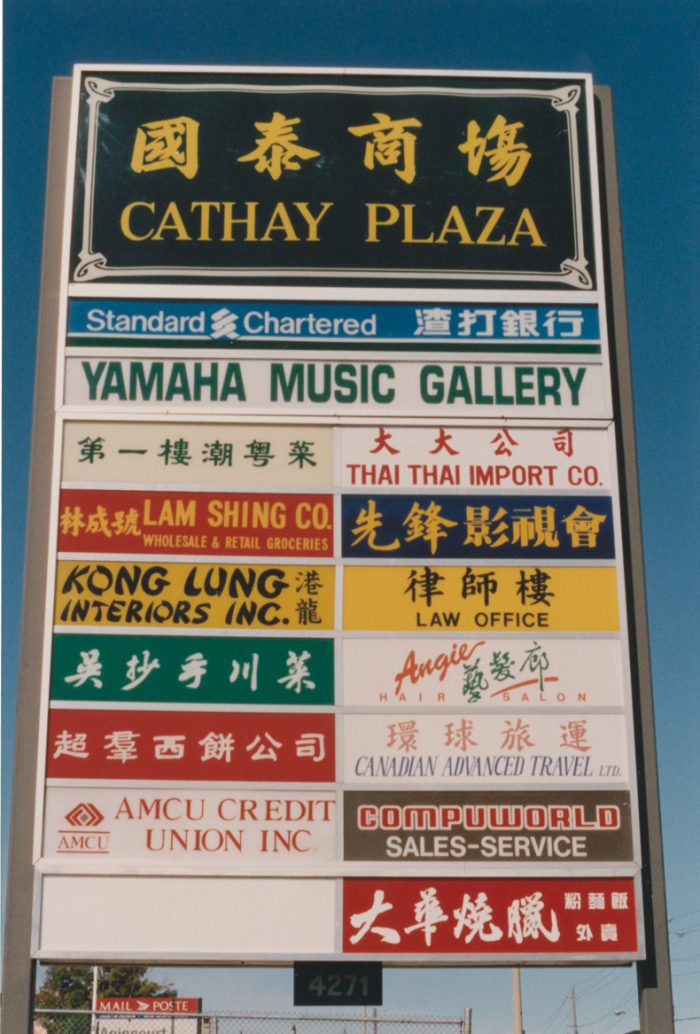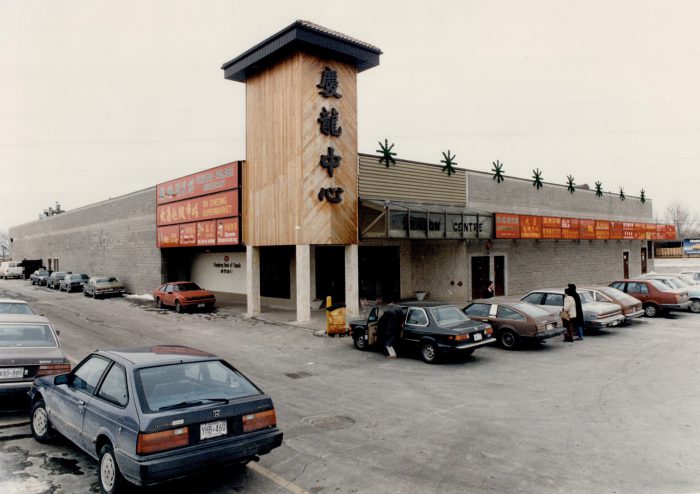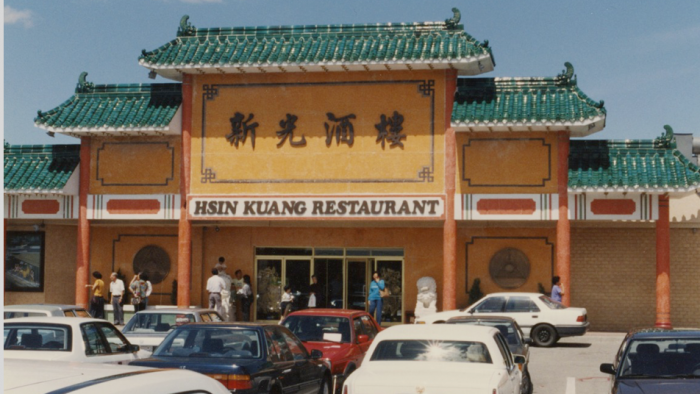History of the Dragon Centre
慶龍中心的歷史

DRAGON CENTRE STORIES
Opened in 1984 in Agincourt, Dragon Centre is North America’s first indoor Chinese mall. It quickly became a commercial and cultural hub for the Chinese-Canadian community and helped kick start the development of suburban Chinese malls in the Greater Toronto Area (GTA). It also became a catalyst for racial tension brought about as existing Agincourt residents adjusted to changing demographic realities.
As the mall winds down after 35 years, it is much remembered by an entire generation of people who came from all over the GTA to eat, shop, and connect. The Dragon Centre Stories Commemoration Project seeks to gather together memories of the mall through community storytelling and documentation.
As you walk through the exhibit, you will encounter the words of historians, the images from a contemporary photographer, old newspaper articles and vintage photographs, along with stories from the community: neighbours and shoppers.
Share your story of the Dragon Centre with us at dragoncentrestories.ca or using #DragonCentreStories on social media.
慶龍中心的故事
慶龍中心於1984年在愛靜閣開業,是北美第一家室內中國商場。它迅速成為中加社區的商業和文化中心,並幫助帶動了大多倫多地區其他的中國商場的發展。隨著現有愛靜閣居民逐漸適應不斷變化的人口現實,慶龍中心也成為緩解種族緊張的催化劑。
隨著商場在35年後的逐漸結業,大多倫多地區整整一代人會記住這個吃飯,購物,交流的地方。慶龍中心故事紀念項目旨在通過社區故事和文檔紀錄來收集人們對商場的記憶。
當您走過展覽時,您將會邂逅歷史學家的文字,當代攝影師的照片,舊報紙的文章和老式照片,以及來自社區鄰居和購物者的故事。
請與我們在dragoncentrestories.ca分享你與慶龍中心的故事,或者在社交媒體使用標籤#DragonCentreStories

The Cathay Plaza, also known as Torchin Plaza, was one of the original strip malls that drove the extension of Scarborough’s Chinese businesses.
1991年,國泰商場位於Sheppard街東側和Midland街。攝影師:Heidi Arra
國泰商場是士嘉堡最初的商業區,推動了其他中國企業的擴張

雲華商場的標誌,位於Sheppard街東側。圖片由Culinaria研究中心提供。

2014年,鴻福海鮮大酒樓。圖片由士嘉堡多倫多大學,Culinaria研究中心提供。
FROM AGINCOURT TO “ASIANCOURT”
Today, Scarborough is home to many from around the world who have transformed a postwar suburb into a transnational place. Before the arrival of the British in the 1800s, First Nations people inhabited the Greater Toronto region for over 10,000 years. Colonial settlement practices, however, erased indigenous histories. After the Second World War, Scarborough’s farmlands were replaced by new residential subdivisions separated from industrial buildings and spacious shopping plazas by wide, multi-lane roads.
Beginning in the 1950s, the population of Scarborough began to change. During the postwar period, it was seen as an ideal place to live for the children of European migrants. And with the end of exclusionary immigration laws in 1967, many people from Asia, the British Caribbean, and the former British-ruled East Africa transformed Scarborough into an ethnically mixed suburb.
Today, Scarborough’s largest visible minority is Chinese. During the 1980s, when Canada created a business immigrant program, many Chinese resettled in Vancouver and Toronto as a result of the Handover of Hong Kong in 1997. Rather than move to historic downtown Chinatowns with limited development potential, a number of educated and wealthy Hong Kong migrants decided to buy homes and open businesses in the suburbs. By the mid 80s, approximately 40,000 Chinese-Canadians lived in Scarborough, 25,000 of whom were concentrated in the Agincourt area. The first Chinese shops opened at the intersection of Glen Watford and Sheppard in the late 1970s, and others soon followed.
The lure of the suburbs, with its new housing stock and family-oriented social landscape, is the main reason why the first Asian indoor mall was built in Agincourt instead of downtown Toronto. Agincourt–the site of a significant English victory against the French in 1415 during the Hundred Years’ War –became “Asiancourt,” a shorthand appreciated by some, offensive to others.
從AGINCOURT 到 “ASIANCOURT”
今天,士嘉堡已經成為世界各地許多人的家園,他們一起把戰後的郊區變成了一個跨域國界的地方。在19世紀英國人到來之前,第一民族居住在大多倫多地區已經有一萬多年的歷史。然而,由於殖民的定居而抹去了土著人過去的歷史。第二次世界大戰結束後,士嘉堡過去的的農田被新的住宅小區所取代,這些小區與工業建築和寬敞的購物廣場被多條寬闊的公路車道分隔而開。
從20世紀50年代開始,士嘉堡的人口開始發生變化。在戰後時期,它被視為歐洲移民子女的理想居住地。隨著1967年移民法的終結,越來越多的人來自亞洲、英國加勒比海、前英國統治的東非,他們將士嘉堡變成了一個多種族混居的社區。
今天,士嘉堡最大的少數民族是中國人。20世紀80年代,當加拿大創建商業移民計劃時,由於1997年香港回歸,許多中國人在溫哥華和多倫多重新定居。與其搬到歷史悠久但是發展潛力有限的市中心唐人街,一些受過教育和富裕的香港移民決定在稍偏離市中心的郊區購買住房和開辦企業。到80年代中期,大約40,000名華裔加拿大人居住在士嘉堡,其中25,000人集中居住在愛靜閣地區。 20世紀70年代後期,第一批中國商店在Glen Watford和Sheppard的交匯處開業,其他商店很快加入了進來。
遠離市區的誘惑,新的住房和以家庭為導向的社會景觀,是第一個亞洲室內購物中心建在愛靜閣而不是多倫多市中心的主要原因。 阿金库尔战役(Agincourt) – 1415年百年戰爭期間英國人在法國取得重大勝利的地點 – 在這裡又被稱為“亞洲人的聚集地” (Asiancourt),這個名字很快被很多人迅速記住,當然有些人也因此受到了冒犯。

1991年,慶龍中心裡的大昌超級市場。攝影師:Heidi Arra
TROUBLES IN SUBURBAN CHINATOWN
Brothers Daniel and Henry Hung purchased the property on Glen Watford Drive in the early 1980s to redevelop it into a mall serving the growing Chinese population. What would become Dragon Centre was adjacent to a baseball diamond and was a roller skating rink popular during the 60s and 70s.
The reconversion was a success, attracting hundreds of shoppers from the GTA on weekends. However, the opening of Dragon Centre exposed Scarborough’s lack of preparedness for urban growth and change: the area was zoned for commercial use while it sat on a collector road in a residential neighbourhood. This was a recipe for disaster. Existing shop owners, facing an economic slowdown, complained about congestion and the overflowing of Chinese shoppers’ cars on their parking lots. They hired security and erected barricades to restrict access. Neighbouring residents also complained about increased traffic and parking on local streets.
Tensions over Scarborough’s development were couched in racially charged terms. On May 28, 1984, hundreds of local residents and business owners met to air out their grievances about the lack of parking but mostly about the changing make-up of their community. Anti-Chinese fliers circulated in the area. These episodes of racial animosity drew the attention of national media.
The Federation of Chinese Canadian in Scarborough was created in the aftermath to provide a united platform for the community. Representatives participated in the City of Scarborough’s newly created Mayor’s Task Force on Race Relations as well as the Multicultural and Race Relations Committee. During the 1990s, tensions continued to flare as new malls and plazas opened in the Midland and Sheppard area, Brimley and Huntingwood, and north-west to Markham and Richmond Hill. The question of racism was further complicated as Asian migration became more diverse – including Chinese migrants from China, Hong Kong, and Taiwan. More established Asian Canadian residents began to express concern that these new malls would increase traffic, safety, and sanitation problems that threatened their suburban way of life.
郊區唐人街的問題
20世紀80年代初,熊氏兄弟丹尼爾和亨利購買了在Glen Watford Drive的物業,將其重新開發成為一個新型購物中心,從而為不斷增長的中國人口服務。由此還創建了60,70年代流行的棒球場和輪滑溜冰場毗鄰當時的慶龍中心。
成功的轉型每個週末都吸引了數百名來自大多倫多地區的購物者。然而,慶龍中心的開放卻暴露了士嘉堡對於城市發展和變化的準備不足:該區域被劃為商業用區,同時它卻坐落在住宅區的連絡道路上。這是一場災難的開始,面對經濟放緩的現有店主,他們抱怨擁堵的交通和中國購物者侵佔了本屬於他們車位的停車場上。他們僱用了警衛同時豎立了障礙欄以限制購物者進入。鄰近的居民也抱怨交通量增加和以及前來的人們佔用了他們當地街道停車。
士嘉堡種族緊張的發展形式愈演愈烈。 1984年5月28日,數百名當地居民和企業主在會面時表達了他們對缺乏停車,但主要是關於他們社區變化的不滿。反華的海報和傳單在該地區流傳。這些種族仇恨事件也引起了國家媒體的注意。
為了給社區提供一個統一的平台,士嘉堡成立了加拿大華人聯合會。華人代表們參加了士嘉堡市新成立的市長種族關係特別工作組以及多元文化和種族關係委員會。20世紀90年代,隨著新的購物中心和廣場在Midland和Sheppard地區,Brimley和Huntingwood,以及萬錦市西北部和列治文山開張,緊張局勢繼續爆發。種族主義問題變得進一步複雜,因為來自亞洲的移民變得更加多樣化 – 其中包括來自中國大陸,香港和台灣的中國移民。更多的亞裔加拿大居民開始擔心這些新購物中心會增加威脅其郊區生活方式的交通,安全和環境衛生問題。



1992年,義和堂參茸藥行位於Sheppard街的珍品廣場。圖片來自安大略省多元文化歷史學會。
ASIAN MALL ARCHITECTURAL HERITAGE
The design of Dragon Centre was a straightforward conversion of a one-story box structure through the subdivision of its interior spaces and minor exterior changes. This indoor mall was unusual in that it brought together two distinctive retailing strategies: Hong Kong’s dense markets and North America’s shopping centres. Dragon Centre was a truly transnational form of architecture that went on to influence Asian mall design in the GTA.
The creation of a double-loaded corridor that supported additional store units was profitable. This hallway also provided shelter from Ontario’s hot summers and frigid winters. This space was highly informal. Sometimes merchandise spilled onto the corridor “sidewalk.” Shopkeepers placed folding chairs outside their entrance, inviting customers to linger.
Beginning in the late 19th century, overseas Chinese entrepreneurs promoted architecture modelled on a northern Chinese imperial style even though most migrants until the 1950s were from southern China. This stereotypical architecture was meant to attract a tourist crowd. In Scarborough, however, the intended audience consisted of fellow Chinese and Asian migrants – and had a more functional feel. The original Dragon Centre entrance was anchored by a wood-slatted tower topped by a hipped roof that was minimalist and generically Asian. It was later replaced by a more futuristic style of gleaming white tiles and a swooping metal grille that expressed Hong Kong’s spectacular growth during the 80s.
By 1988, Agincourt was known as Toronto’s third Chinatown, and a fourth “Chinatown,” was under construction in Mississauga. The majority of these planned shopping centres included interior spaces. Corridors of tiny shops typically opened onto a light-filled atrium anchored by a fountain or event stage. Although traffic congestion was a topic of concern outside the mall, the interiors spoke of a more positive effect of “traffic.” These malls were designed as spaces of belonging shaped by high density living in Asia, which in turn shaped the social life and heritage of the diaspora.
亞洲購物中心的建築遺產
慶龍中心的設計是由直接轉換為單層箱體結構通過其內部空間的細分和輕微的外部變化組成的。這個室內購物中心之所以與眾不同,因為它匯集了兩個獨特的零售策略:香港的密集市場和北美的購物中心。慶龍中心是一個真正的跨國建築形式,從而對大多倫多地區亞洲購物中心的設計有著深遠的影響。
創建雙向商品舖走廊的利潤非常可觀。這條走廊為安大略省炎熱的夏季和寒冷的冬天提供了很好的庇護場所。商場的空間佈置非常生活化,有時商家把商品擺在走廊人們經過的地方,店主也會在門前放置折疊椅跟路過的顧客聊天。
從19世紀後期開始,海外華人企業家開始推動中國北方帝國風格的建築,儘管大多數移民直到20世紀50年代都來自中國南方。這種陳規定型的建築的主旨是為了吸引旅遊人群。然而在士嘉堡,他們的市場顧客大多是來自中國和亞洲移民,他們更加傾向於功能性強的建築。最初的慶龍中心入口處是一個木板條的塔樓,頂部是一個極簡主義代表了亞洲的四坡屋頂。它後來被更具未來主義風格的閃亮白色瓷磚和俯沖金屬格柵所取代,表達了香港80年代的壯觀增長。
到1988年,愛靜閣被稱為多倫多的第三個中國城,同時第四個“中國城”也正在密西沙加建立起來。大多數這者購物中心的建立包括對商場內部空間的設計都是有計劃的。 通常小商店的走廊會固定搭建噴泉和活動舞台在充滿光線的中庭上。 雖然交通擁堵是商場外備受關注的話題,但內部談的卻是“交通”為商場帶來的更積極的影響。這些商場的設計還原了亞洲高密度生活的形式空間,這反過來也塑造和說明了社會生活和文化遺產的大移居。

1991年,新光酒樓位於Kennedy路和Finch街西側的美麗徑廣場購物中心。攝影師:Heidi Arra